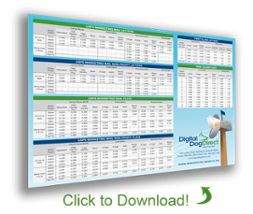
It’s no secret that one of the keys to maximizing ROI from your direct mail campaigns is minimizing postage costs. The USPS has very specific criteria and requirements for different mail formats and classes, all of which affect postage. Here are some of the basics that every organization considering direct mail should know.
Postcards, Letters, Flats, and Parcels
A postcard is exactly that – a card with no envelope – and is 3 1/2 x 5 inches to 4 1/4 x 6 inches, up to .016 inches thick. With USPS marketing mail, however, postcards of this size have the same postage as letters. In other words, there isn’t a lower postcard price.
A letter, which can be a rectangular card or envelope, is the easiest mail format for the USPS to process. Mailings must be no more than 1/4 inches thick and fall between a minimum of 3 1/2 x 5 inches and a maximum of 6 1/8 x 11 1/2 inches to be classified a letter.
Anything larger is considered a flat, which can drive up direct mail postage by 20-30 percent or more because of its size and weight. A flat is at least 6 1/8 to 12 inches on its shorter side, 11 1/2 to 15 inches on its longer side, OR 1/4 to 3/4 inches thick. A flat still needs to be flexible enough to pass through postal sorting equipment. If the mailing’s container or contents make it rigid, it’s considered a parcel.
A parcel could be an envelope, carton, tube, book, or other container that’s at least 12 inches on the shorter side, 15 inches on its longer side, and 3/4 inches thick. A parcel may have the dimensions of a flat but is too rigid or lumpy to be considered machinable.
Keep in mind that direct mail postage is based in part on whether mailings can be automatically processed by postal service equipment. If mailings meet USPS standards for size, shape, and weight, those mailings are considered machinable and eligible for presorting. If not, they’re nonmachinable, which increases postage costs.
First Class vs. Standard
First Class Mail offers the fastest and most consistent delivery timeframe from the USPS, with direct mail postcards, letters, flats, and small parcels typically delivered in two to four business days. First Class also includes return and forwarding services. To be classified as First Class, letters and postcards must weigh no more than 3.5 ounces, while flats and parcels cannot exceed 13 ounces.
The speed and consistency of First Class make postage more expensive. To get the lowest direct mail postage rates on First Class Mail, make sure postcards and letters are rectangular. For example, square mailings might seem unique and innovative, but they also cost more to mail. Certified presorting of 500 or more pieces by zip code can also help you qualify for lower postage.
Standard Class Mail or Marketing Mail is typically delivered in five to 21 business days and does not include forwarding and return service. This is why Standard postage costs up to 32 percent less per piece than First Class. To qualify for Standard Mail, you need at least 200 pieces and each mailing must weigh less than 16 ounces. You can also reduce postage with presorting.
Working with an experienced direct mail marketing provider is critical to avoiding surprises when postage is calculated. Download our free 2020 Calendar and Direct Mail Postage Rate Sheet to help you budget your next campaign.
Contact us to walk you through the basics of mail formatting and class options and unleash the power of Digital Dog Direct.



Comments